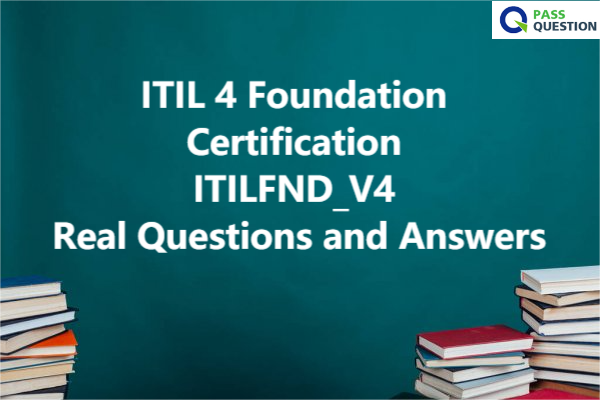ITIL 4 Foundation Certification ITILFND_V4 Real Questions and Answers
The latest ITIL 4 Foundation Certification ITILFND_V4 Real Questions and Answers are new updated to help you pass your exam easily. PassQuestion team collected ITIL 4 Foundation Certification ITILFND_V4 Real Questions and Answers from the real test so that you can practice real questions with verified answers to ensure your 100% success. We assure you that ITIL 4 Foundation Certification ITILFND_V4 Real Questions and Answers will help you cover exam topics and acquire the required knowledge to pass the ITIL 4 Foundation exam. It will help you get a high score in your ITILFND_V4 ITIL 4 Foundation exam on the first attempt!

ITIL 4 Foundation Certification
ITIL 4 Foundation introduces an end-to-end operating model for the creation, delivery and continual improvement of technology-enabled products and services. ITIL 4 Foundation is for anyone who needs to understand the key concepts of IT and digital service delivery, and who is interested in helping their organization embrace the new service management culture. It is for professionals at the start of their ITIL 4 journey or people looking to update their existing ITIL knowledge.
The ITIL 4 Foundation examination is intended to assess whether the candidate can demonstrate sufficient recall and understanding of the ITIL 4 service management framework, as described in the syllabus below, to be awarded the ITIL 4 Foundation qualification. The ITIL 4 Foundation qualification is a prerequisite for the ITIL 4 higher level qualifications, which assess the candidate’s ability to apply their understanding of the relevant parts of the ITIL framework in context.
Exam Information
Number of Questions: 40 questions
Format: Multiple choice
Passing: 26 out of 40 marks required to pass (65%)
Duration: 60 minutes
Exam Objectives
Domain 1: Understand the key concepts of service management
Domain 2: Understand how the ITIL guiding principles can help an organization adopt and adapt service management
Domain 3: Understand the four dimensions of service management
Domain 4: Understand the purpose and components of the ITIL service value system
Domain 5: Understand the activities of the service value chain, and how they interconnect
Domain 6: Know the purpose and key terms of 15 ITIL practices
Domain 7: Understand 7 ITIL practices
View Online ITIL 4 Foundation ITILFND_V4 Free Questions
1.Which is recommended as part of the 'progress iteratively with feedback' guiding principle?
A. Prohibit changes to plans after they have been finalized
B. Organize work into small manageable units
C. Reduce the number of steps that produce tangible results
D. Analyse the whole situation in detail before taking any action
Answer: B
2.What is included in the purpose of the 'continual improvement' practice?
A. Ensuring that delivery of services is properly assessed, monitored, and improved against targets
B. Identifying and continually improving relationships with and between stakeholders
C. Creating collaborative relationships with key suppliers to realize new value
D. Aligning the organization's practices and services with changing business needs
Answer: D
3.Which term is used to describe removing something that could have an effect on a service?
A. A change
B. An incident
C. An IT asset
D. A problem
Answer: D
4.How does the 'incident management' practice set user expectations?
A. By using collaboration tools to communicate effectively
B. By agreeing, and communicating target resolution time
C. By assigning resources to ensure that all incidents are resolved as quickly as possible
D. By automated matching of incidents to known errors
Answer: C
5.What is the difference between the 'incident management' and 'service desk' practices?
A. Incident management resolves complex issues, service desk resolves simpler issues
B. Incident management restores service operation, service desk provides communication with users
C. Incident management manages interruptions to services, service desk monitors achieved service quality
D. Incident management resolves issues service desk investigates the underlying causes of issues
Answer: B
6.What is a user?
A. The role that uses services
B. The role that authorizes budget for service consumption
C. The role that defines the requirements for a service
D. The role that directs and controls an organization
Answer: A
7.Which is a description of service provision?
A. Activities that an organization performs to deliver services
B. Away to help create value by facilitating outcomes that service consumers need
C. Cooperation between two organizations to ensure that a service delivers value
D. A formal description of one or more services, designed to address the needs of a service consumer
Answer: B
8.How do 'continual improvement registers' help to create value?
A. By monitoring achievement against service level targets
B. By making improvements visible
C. By assigning change authorities for change requests
D. By documenting all improvement ideas in a single place
Answer: B
9.Which statement about the inputs and outputs of the value chain activities is CORRECT?
A. Inputs and outputs are fixed for each value chain activity
B. Each value chain activity receives inputs and provides outputs
C. Some value chain activities only have inputs, whereas others only have outputs
D. The organization's governance will determine the inputs and outputs of each value chain activity
Answer: B
10.What is the value of a service?
A. A result for a stakeholder enabled by the outputs of the service
B. A tangible or intangible deliverable of the service
C. The amount of money that is created or saved for the service consumers by using the service
D. The benefits, usefulness, or importance of the service, as perceived by the stakeholders
Answer: D